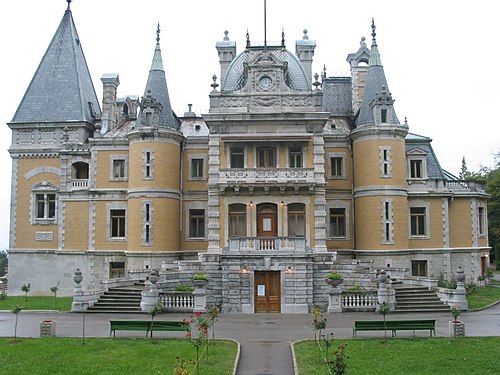



Châteauesque (orFrancis I style,[1] or inCanada, theChâteau Style[2]) is arevivalistarchitectural style based on theFrench Renaissance architecture of the monumentalchâteaux of the Loire Valley from the late fifteenth century to the early seventeenth century.
The termchâteauesque (literally, "château-like") is credited (by historianMarcus Whiffen) to American architectural historianBainbridge Bunting,[1] although it can be found in publications that pre-date Bunting's birth. As of 2011, theGetty Research Institute'sArt & Architecture Thesaurus includes both "Château Style" and "Châteauesque", with the former being the preferred term for North America.
The style frequently features buildings heavily ornamented by the elaborate towers, spires, and steeply-pitched roofs of sixteenth century châteaux, themselves influenced by lateGothic andItalian Renaissance architecture. Despite their French ornamentation, as a revival style, buildings in the châteauesque style do not attempt to completely emulate a French château. Châteauesque buildings are typically built on an asymmetrical plan, with a roof-line broken in several places and a facade composed of advancing and receding planes.
The style was popularized in the United States byRichard Morris Hunt. Hunt, the first American architect to study at theÉcole des Beaux-Arts in Paris,[3] designed residences, including those for theVanderbilt family, during the 1870s, 1880s and 1890s.[4] A relatively rare style in the United States, its presence was concentrated in theNortheast,[3] although isolated examples can be found in nearly all parts of the country. It was mostly employed for residences of the extremely wealthy, although it was occasionally used for public buildings.
The first building in this style in Canada was the 1887Quebec City Armoury (now named the Voltigeurs de Québec Armoury, formerly called the Grande-Allée Armoury (French: Manège militaire Grande-Allée, or simply Manège militaire) designed byEugène-Étienne Taché.[5] Many ofCanada's grand railway hotels, designed byJohn Smith Archibald,Edward Maxwell,Bruce Price andRoss and Macdonald, were built in the Châteauesque style, with other mainly public or residential buildings. The style may be associated with Canadian architecture because these grand hotels are prominent landmarks in major cities across the country and in certain national parks.
In Hungary,Arthur Meinig built numerous country houses in the Loire Valley style, the earliest being Andrássy Castle inTiszadob, 1885–1890, and the grandest being Károlyi Castle in Nagykároly (Carei), 1893–1895.
The style began to fade after the turn of the 20th century, and it was largely absent from new construction by the 1930s.
Many of the Châteauesque-style buildings in Canada were built by railway companies, and their respective hotel divisions. They includeCanadian National Railway andCanadian National Hotels,Canadian Pacific Railway andCanadian Pacific Hotels, and theGrand Trunk Railway.